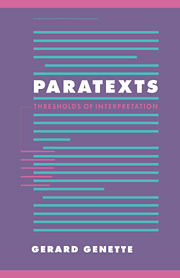Book contents
- Frontmatter
- Contents
- Foreword
- List of books by Gérard Genette
- Translator's note
- 1 Introduction
- 2 The publisher's peritext
- 3 The name of the author
- 4 Titles
- 5 The please-insert
- 6 Dedications and inscriptions
- 7 Epigraphs
- 8 The prefatorial situation of communication
- 9 The functions of the original preface
- 10 Other prefaces, other functions
- 11 Intertitles
- 12 Notes
- 13 The public epitext
- 14 The private epitext
- 15 Conclusion
- Additional references
- Index
3 - The name of the author
Published online by Cambridge University Press: 04 November 2009
- Frontmatter
- Contents
- Foreword
- List of books by Gérard Genette
- Translator's note
- 1 Introduction
- 2 The publisher's peritext
- 3 The name of the author
- 4 Titles
- 5 The please-insert
- 6 Dedications and inscriptions
- 7 Epigraphs
- 8 The prefatorial situation of communication
- 9 The functions of the original preface
- 10 Other prefaces, other functions
- 11 Intertitles
- 12 Notes
- 13 The public epitext
- 14 The private epitext
- 15 Conclusion
- Additional references
- Index
Summary
Place
Nowadays it seems both necessary and “natural” to record the name – authentic or fictive – of the author in the peritext, but this has not always been so, if we judge by the common use of anonymity in the classical period. That common classical practice (which I shall say more about below) shows that the invention of the printed book did not impose this particular paratextual element (the name of the author) as quickly and firmly as it imposed certain others. Recording the author's name was even less necessary and natural in the era of ancient and medieval manuscripts, a period lasting for centuries, when there was, so to speak, no place available to put such information as the name of the author and the title of the work, except for a reference incorporated, or rather buried, in the opening (incipit) or closing (explicit) sentences of the text. It is in this form of an incorporated reference (which we will meet again in connection with titles and prefaces) that we have the names of, for example, Hesiod (Theogony line 22), Herodotus (first word of the Histories), Thucydides (same location), Plautus (prologue of Pseudolus), Virgil (closing lines of the Georgics), the romance-writer Chariton of Aphrodisias (at the head of Chaereas and Callirhoe), Chrétien de Troyes (at the head of Perceval,) and Geoffroy de Lagny (Chrétien's successor for Lancelot), Guillaume de Lorris and Jean de Meung (whose names are recorded at the juncture of their respective works, at line 4059 of Roman de la rose), “Jean Froissart, treasurer and canon of Chimay,” and of course Dante (canto 30, line 55, of Purgatory).
- Type
- Chapter
- Information
- ParatextsThresholds of Interpretation, pp. 37 - 54Publisher: Cambridge University PressPrint publication year: 1997
- 1
- Cited by

